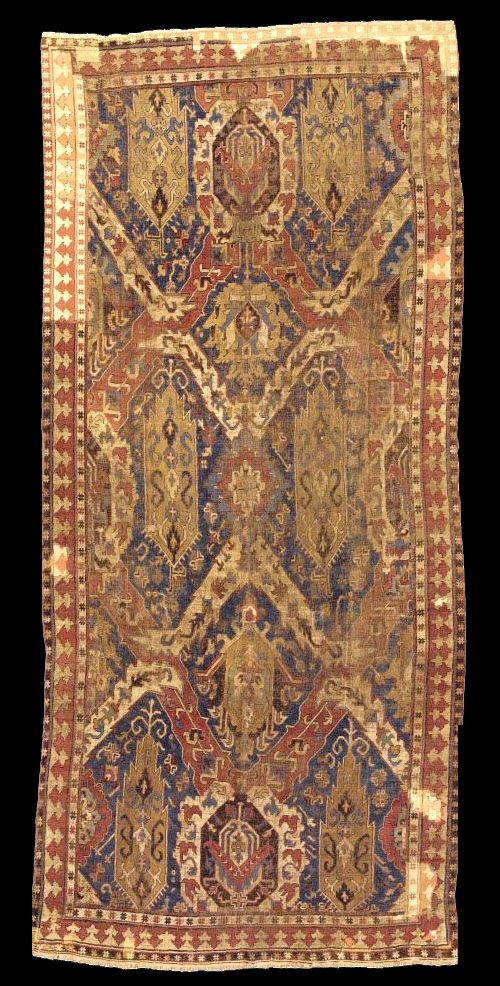Sotheby's Sale: N08456 | Location: New York
Auction Dates: Session 1: Wed, 11 Jun 08 10:00 AM
LOT 119 (of 224)
PROPERTY OF A PRIVATE COLLECTOR
A CAUCASIAN FRAGMENTARY 'DRAGON' CARPET,
18th century
reduced in size, oxidized browns, reweaves, repiling, patches, reselvaged
10,000—15,000 USD
Lot Sold. Hammer Price with Buyer's Premium: 20,000 USD
MEASUREMENTS: approximately 15ft. 2in. by 6ft. 8in. (4.62 by 2.03m.)
DESCRIPTION: 18th century
reduced in size, oxidized browns, reweaves, repiling, patches, reselvaged
PROVENANCE: Collection of David Sylvester
LITERATURE AND REFERENCES: Simon Franses, "The David Sylvester Collection,"
Hali, Issue 120, January-February 2002, p. 39 showing this carpet surrounded
by antiquities in Mr Sylvester's home.
CATALOGUE NOTE
Unlike most Caucasian rugs, where classification is not made by design alone
as it is often done with weavings from Anatolia, Turkmenistan, and Persia,
'Dragon' carpets are so named for their emblematic design showing a lattice
of leaf shapes containing dragons. The inclusion of dragons is the most
evident link between these early Caucasian carpets and Chinese art. However,
by the time the 'Dragon' design reached Shusha, where it is believed to have
first appeared in the Caucasus, the figural elements had become highly
stylized and geometric. The most commonly used ground color for these rugs
was red, but occasionally yellow, brown and blue, as is the current lot,
were used. An intriguing feature of this carpet is the extreme stylization
and orientation of the dragons. Usually the dragons are placed with their
heads upward between the intertwining lattice. Here, the dragons have become
abstract hexagonal shapes with serrated ends, suggesting a dating of the
carpet to the eighteenth century. 'Dragon' carpets from the 1600s tend to
have more organic shapes with the dragons more detailed and curvilinear. In
even later carpets the dragons evolved into simple geometric forms, such as
the eighteenth century example illustrated in Serare Yetkin, Early Caucasian
Carpets in Turkey Vol. 1, London, 1978, pl. 21. For an example of a 'Dragon'
carpet exhibiting partially stylized dragons, see Charles Grant Ellis, Early
Caucasian Rugs, Washington, D.C., 1975, p. 16, fig. 7. A comparable example
was sold Sotheby's New York, October 8, 1999, lot 46 and an
eighteenth-century 'Dragon' carpet with similarly stylized dragons was sold
Sotheby's London, September 20, 2006, lot 115.
Please see note to lot 6 in this catalogue for further information on
provenance. |

